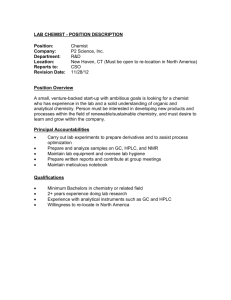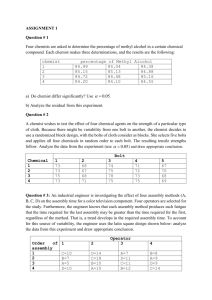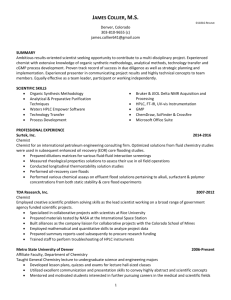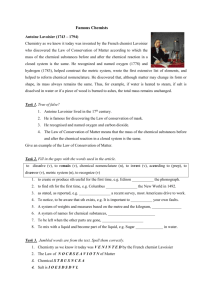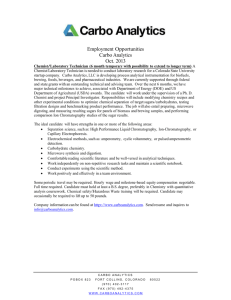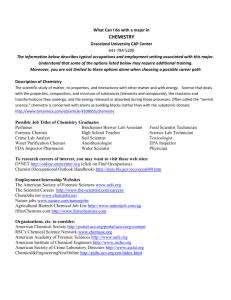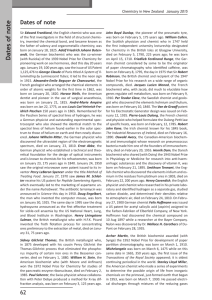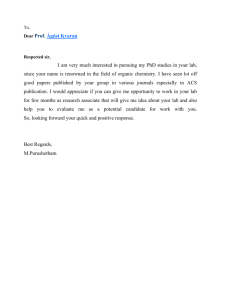Dates of Note - New Zealand Institute of Chemistry
advertisement
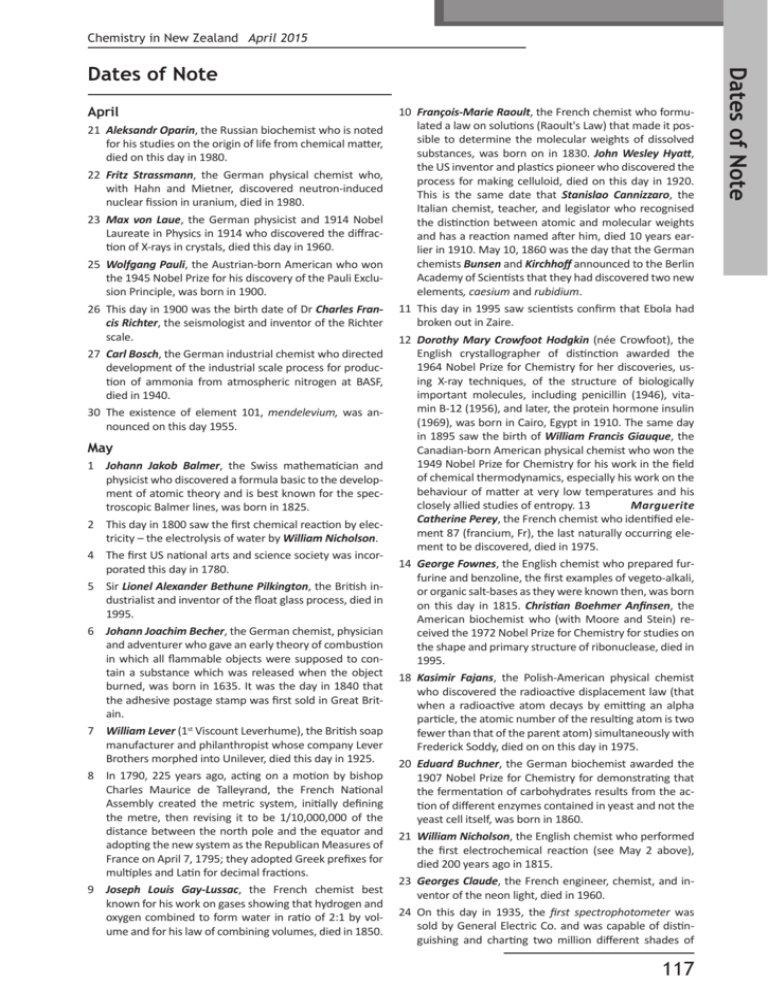
Chemistry in New Zealand April 2015 April 21 Aleksandr Oparin, the Russian biochemist who is noted for his studies on the origin of life from chemical matter, died on this day in 1980. 22 Fritz Strassmann, the German physical chemist who, with Hahn and Mietner, discovered neutron-induced nuclear fission in uranium, died in 1980. 23 Max von Laue, the German physicist and 1914 Nobel Laureate in Physics in 1914 who discovered the diffraction of X-rays in crystals, died this day in 1960. 25 Wolfgang Pauli, the Austrian-born American who won the 1945 Nobel Prize for his discovery of the Pauli Exclusion Principle, was born in 1900. 26 This day in 1900 was the birth date of Dr Charles Francis Richter, the seismologist and inventor of the Richter scale. 27 Carl Bosch, the German industrial chemist who directed development of the industrial scale process for production of ammonia from atmospheric nitrogen at BASF, died in 1940. 30 The existence of element 101, mendelevium, was announced on this day 1955. May 1 Johann Jakob Balmer, the Swiss mathematician and physicist who discovered a formula basic to the development of atomic theory and is best known for the spectroscopic Balmer lines, was born in 1825. 2 This day in 1800 saw the first chemical reaction by electricity – the electrolysis of water by William Nicholson. 4 The first US national arts and science society was incorporated this day in 1780. 5 Sir Lionel Alexander Bethune Pilkington, the British industrialist and inventor of the float glass process, died in 1995. 6 Johann Joachim Becher, the German chemist, physician and adventurer who gave an early theory of combustion in which all flammable objects were supposed to contain a substance which was released when the object burned, was born in 1635. It was the day in 1840 that the adhesive postage stamp was first sold in Great Britain. 7 William Lever (1st Viscount Leverhume), the British soap manufacturer and philanthropist whose company Lever Brothers morphed into Unilever, died this day in 1925. 8 In 1790, 225 years ago, acting on a motion by bishop Charles Maurice de Talleyrand, the French National Assembly created the metric system, initially defining the metre, then revising it to be 1/10,000,000 of the distance between the north pole and the equator and adopting the new system as the Republican Measures of France on April 7, 1795; they adopted Greek prefixes for multiples and Latin for decimal fractions. 9 Joseph Louis Gay-Lussac, the French chemist best known for his work on gases showing that hydrogen and oxygen combined to form water in ratio of 2:1 by volume and for his law of combining volumes, died in 1850. 10 François-Marie Raoult, the French chemist who formulated a law on solutions (Raoult's Law) that made it possible to determine the molecular weights of dissolved substances, was born on in 1830. John Wesley Hyatt, the US inventor and plastics pioneer who discovered the process for making celluloid, died on this day in 1920. This is the same date that Stanislao Cannizzaro, the Italian chemist, teacher, and legislator who recognised the distinction between atomic and molecular weights and has a reaction named after him, died 10 years earlier in 1910. May 10, 1860 was the day that the German chemists Bunsen and Kirchhoff announced to the Berlin Academy of Scientists that they had discovered two new elements, caesium and rubidium. 11 This day in 1995 saw scientists confirm that Ebola had broken out in Zaire. 12 Dorothy Mary Crowfoot Hodgkin (née Crowfoot), the English crystallographer of distinction awarded the 1964 Nobel Prize for Chemistry for her discoveries, using X-ray techniques, of the structure of biologically important molecules, including penicillin (1946), vitamin B-12 (1956), and later, the protein hormone insulin (1969), was born in Cairo, Egypt in 1910. The same day in 1895 saw the birth of William Francis Giauque, the Canadian-born American physical chemist who won the 1949 Nobel Prize for Chemistry for his work in the field of chemical thermodynamics, especially his work on the behaviour of matter at very low temperatures and his closely allied studies of entropy. 13 Marguerite Catherine Perey, the French chemist who identified element 87 (francium, Fr), the last naturally occurring element to be discovered, died in 1975. 14 George Fownes, the English chemist who prepared furfurine and benzoline, the first examples of vegeto-alkali, or organic salt-bases as they were known then, was born on this day in 1815. Christian Boehmer Anfinsen, the American biochemist who (with Moore and Stein) received the 1972 Nobel Prize for Chemistry for studies on the shape and primary structure of ribonuclease, died in 1995. 18 Kasimir Fajans, the Polish-American physical chemist who discovered the radioactive displacement law (that when a radioactive atom decays by emitting an alpha particle, the atomic number of the resulting atom is two fewer than that of the parent atom) simultaneously with Frederick Soddy, died on on this day in 1975. 20 Eduard Buchner, the German biochemist awarded the 1907 Nobel Prize for Chemistry for demonstrating that the fermentation of carbohydrates results from the action of different enzymes contained in yeast and not the yeast cell itself, was born in 1860. 21 William Nicholson, the English chemist who performed the first electrochemical reaction (see May 2 above), died 200 years ago in 1815. 23 Georges Claude, the French engineer, chemist, and inventor of the neon light, died in 1960. 24On this day in 1935, the first spectrophotometer was sold by General Electric Co. and was capable of distinguishing and charting two million different shades of 117 Dates of Note Dates of Note Chemistry in New Zealand April 2015 colour. John Mayow, the English chemist and physiologist who identified oxygen as a distinct atmospheric entity about a hundred years before Joseph Priestley and Antoine-Laurent Lavoisier, was born in 1640. 27 John Davy, the English chemist, doctor and younger brother of Humphry Davy, who first prepared, named and characterised the gas phosgene, was born 1790. Lars Fredrik Nilson, the Swedish chemist who discovered scandium and its oxide in the rare-earth minerals gadolinite and euxenite, was born in 1840. 31 Sir Arthur Herbert Church, the English chemist and mineralogist who was a leading authority in the chemistry of painting, and discovered turacin (an animal pigment containing copper) and several minerals, including the only British cerium mineral, died 100 years ago. June 2 Jesse Boot (1st Baron Trent), the English chemist who founded Boots Company Ltd., was born on in 1850. 5 Johan Gadolin, the Finnish chemist who discovered the element yttrium in 1794, the first of the lanthanides, and has gadolinium named for him, was born in 1760. 8 Tim Berners-Lee, the English computer scientist who invented the World Wide Web, has his 60th birthday this year on this day. It is also the day in 1940 that the discovery of neptunium (Np, element 93) was announced by McMillan and Abelson working at the University of California at Berkeley. 9 On this day in 1905, Einstein published his analysis of Max Planck's quantum theory and its application to light, the insights of which earned him his Nobel Prize. In addition, in 1795, a provisional metre bar was constructed in brass by Lenoir under the direction of Jean Borda; it was a platinum bar about 25×4 mm, the distance between the ends, in the manner of a guage block, was the accepted unit of length. 10 Wilhelm Friedrich (Willy) Kühne, the German physiologist whose research focussed on the chemical changes occurring in the retina under the influence of light, died in 1900. 15 Comte de Antoine Francois Fourcroy, the French chemist who worked with Lavoisier and was one of the first to study foodstuffs and fats, was born in 1775. 16 Max Delbrück, the German chemist who developed the fermentation industry, established a school for distillation workers, and a glass factory for the manufacture of reliable apparatus and instruments, was born in 1850. 17 Sir Arthur Harden, the English biochemist who shared the 1929 Nobel Prize for Chemistry (with von EulerChelpin) for work on the fermentation of sugar and the enzyme action involved, died in 1940 (see: This Journal, 2014, 78, 169-174). 18 Per Teodor Cleve, the Swedish chemist and geologist who discovered the elements holmium and thulium, died in 1905. It is the day in 1865, 150 years ago that Edmund Ruffin, the father of soil chemistry in the US, died. 19 Paul J. Flory, the American physical chemist, recipient of the Nobel Prize for Chemistry in 1974 for his investigations of synthetic and natural macromolecules, was born this day in 1910. James Bertram Collip, the Canadi- 118 an biochemist who co-discovered insulin, died 50 years ago in 1965. Nicolas Lémery, the French chemist and pharmacist who prepared a comprehensive dictionary of pharmaceuticals in the Pharmacopée universelle and the Traité des drogues simples, died in 1715 – 200 years ago. 24 Johannes Wislicenus, the German chemist whose pioneering work led to the recognition of the importance of the spatial arrangement of atoms within a molecule, and studied geometrical isomerism, was born in 1835. 26 Roy J. Plunkett, the American chemist and inventor of Teflon (polytetrafluoroethylene, PTFE), was born in 1910. 28 This day in 1960 was the day chlorophyll a was first synthesised by R.B. Woodward. Richard August Carl Emil Erlenmeyer, the German chemist known for contributing to the early development of the theory of structure, and designing the flask named after him, was born in 1825, the day in 1935 that the first virus was reported in crystalline form by Professor Wendell Stanley (19041971) who subsequently received the 1946 Nobel Prize in Chemistry for his work on the tobacco mosaic virus. 29 Alexander Parkes, the British industrial electroplating expert, died in 1890. July 1 Franz-Joseph Müller Freiherr von Reichenstein, the Austrian mineralogist and mining engineer who discovered tellurium, in 1740, 275 years ago. 5François-Pierre Ami Argand, the Swiss chemist who invented an oil burner with a tubular wick inside a glass chimney (the Argand lamp), was born in 1750. Antonio de Ulloa, the Spanish scientist and naval officer who discovered the element platinum, died in 1795. 6 Nathaniel Wyet, the American chemist who created the PET plastic beverage bottle, died in 1990. 8 Joseph Loschmidt, the Austrian chemist and physicist who proposed some kind of cyclic structure for benzene in 1861, died in 1895. 12 Richard Buckminster Fuller, the American inventor, educator, author, philosopher, engineer and architect who developed the geodesic dome, was born this day in 1895. 14 Jean Baptiste André Dumas, the French chemist who was a pioneer in organic chemistry and established quantitative organic analysis, was born in 1800. Maurice de Broglie, the French physicist who made many contributions to the study of X-rays, died this same day in 1960. 18 Johann Gustav Christoffer Kjeldahl, the Danish chemist who originated a method for determining the amount of nitrogen in certain organic compounds using a laboratory technique named after him, died in 1800. 19 Georges Friedel, the French crystallographer who formulated basic laws concerning the external morphology and internal structure of crystals, was born in 1865, 150 years ago.
